The AMD Ryzen Threadripper 1950X and 1920X Review: CPUs on Steroids
by Ian Cutress on August 10, 2017 9:00 AM ESTRocket League
Hilariously simple pick-up-and-play games are great fun. I'm a massive fan of the Katamari franchise for that reason — passing start on a controller and rolling around, picking up things to get bigger, is extremely simple. Until we get a PC version of Katamari that I can benchmark, we'll focus on Rocket League.
Rocket League combines the elements of pick-up-and-play, allowing users to jump into a game with other people (or bots) to play football with cars with zero rules. The title is built on Unreal Engine 3, which is somewhat old at this point, but it allows users to run the game on super-low-end systems while still taxing the big ones. Since the release in 2015, it has sold over 5 million copies and seems to be a fixture at LANs and game shows. Users who train get very serious, playing in teams and leagues with very few settings to configure, and everyone is on the same level. Rocket League is quickly becoming one of the favored titles for e-sports tournaments, especially when e-sports contests can be viewed directly from the game interface.
Based on these factors, plus the fact that it is an extremely fun title to load and play, we set out to find the best way to benchmark it. Unfortunately for the most part automatic benchmark modes for games are few and far between. Partly because of this, but also on the basis that it is built on the Unreal 3 engine, Rocket League does not have a benchmark mode. In this case, we have to develop a consistent run and record the frame rate.
Read our initial analysis on our Rocket League benchmark on low-end graphics here.
With Rocket League, there is no benchmark mode, so we have to perform a series of automated actions, similar to a racing game having a fixed number of laps. We take the following approach: Using Fraps to record the time taken to show each frame (and the overall frame rates), we use an automation tool to set up a consistent 4v4 bot match on easy, with the system applying a series of inputs throughout the run, such as switching camera angles and driving around.
It turns out that this method is nicely indicative of a real bot match, driving up walls, boosting and even putting in the odd assist, save and/or goal, as weird as that sounds for an automated set of commands. To maintain consistency, the commands we apply are not random but time-fixed, and we also keep the map the same (Aquadome, known to be a tough map for GPUs due to water/transparency) and the car customization constant. We start recording just after a match starts, and record for 4 minutes of game time (think 5 laps of a DIRT: Rally benchmark), with average frame rates, 99th percentile and frame times all provided.
The graphics settings for Rocket League come in four broad, generic settings: Low, Medium, High and High FXAA. There are advanced settings in place for shadows and details; however, for these tests, we keep to the generic settings. For both 1920x1080 and 4K resolutions, we test at the High preset with an unlimited frame cap.
All of our benchmark results can also be found in our benchmark engine, Bench.
MSI GTX 1080 Gaming 8G Performance
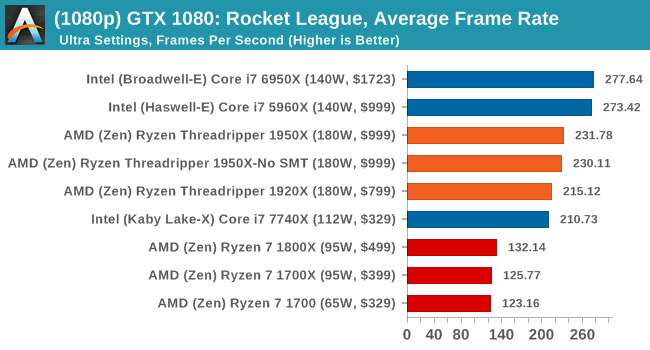
1080p

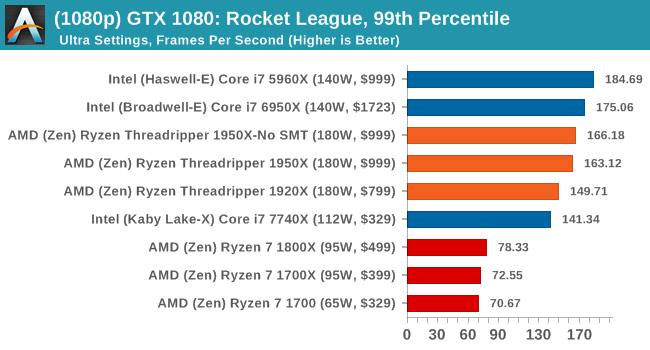
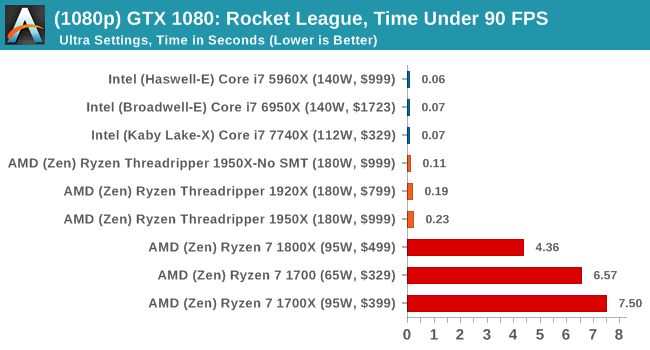
4K

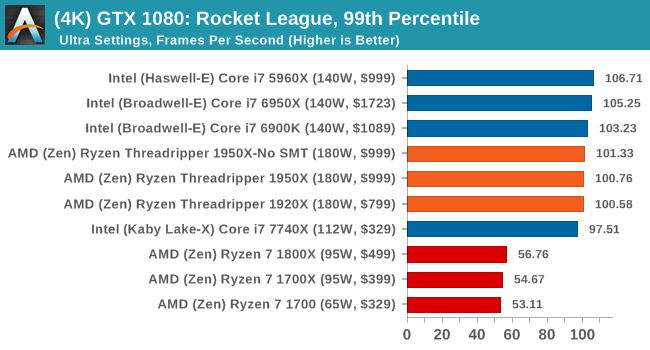
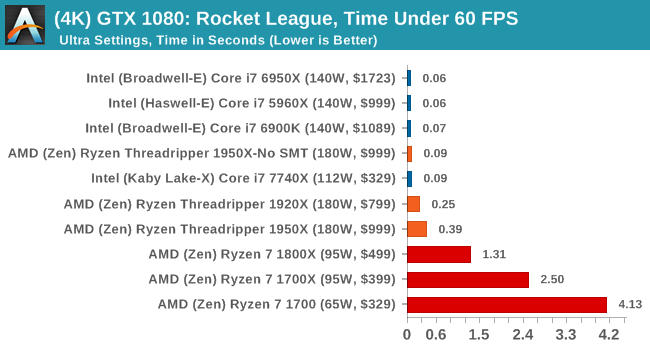
ASUS GTX 1060 Strix 6G Performance
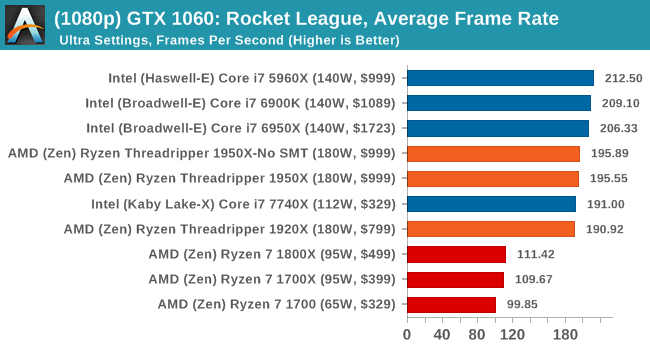
1080p

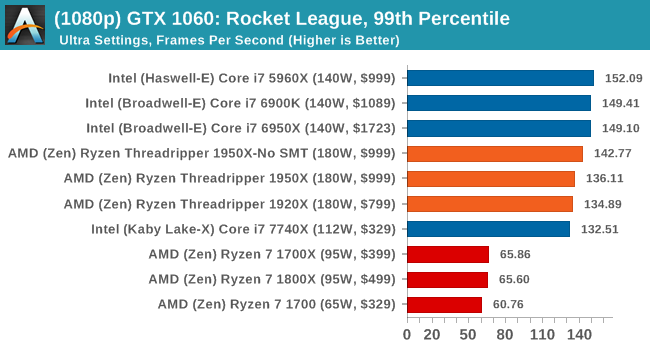
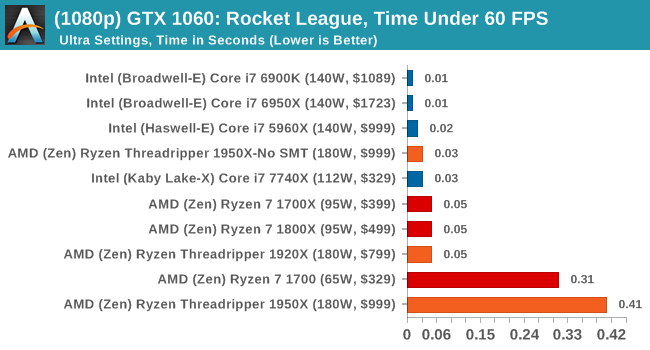
4K
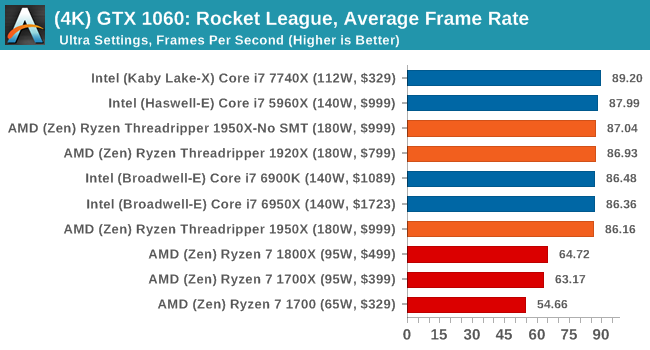
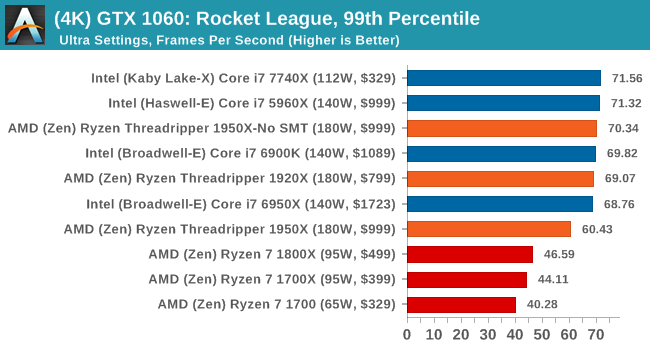
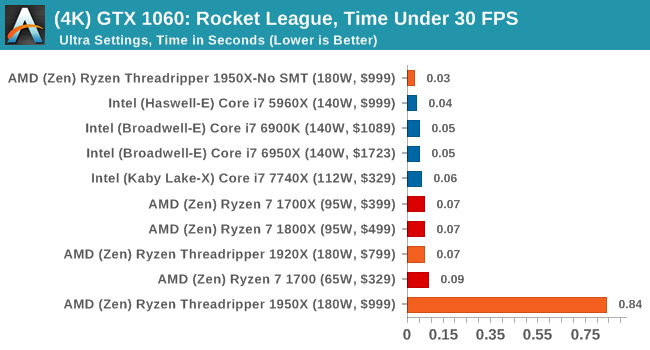
Sapphire Nitro R9 Fury 4G Performance
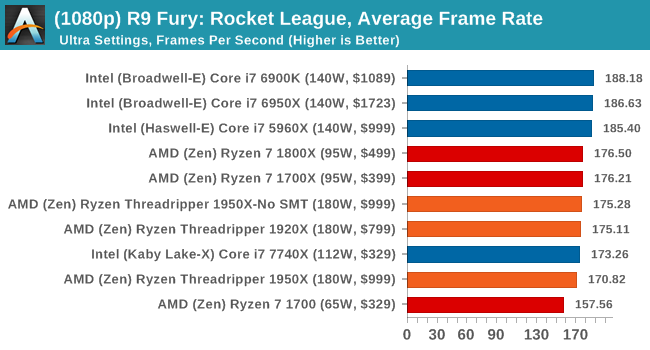
1080p

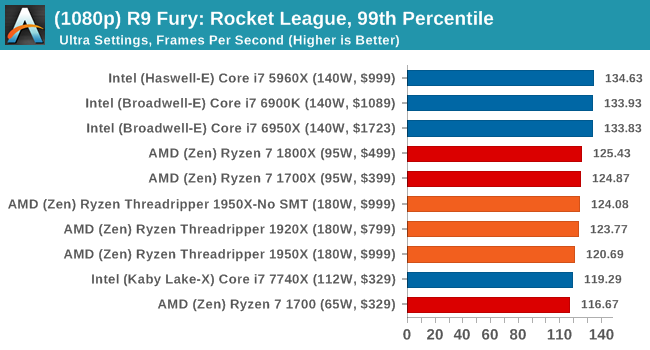
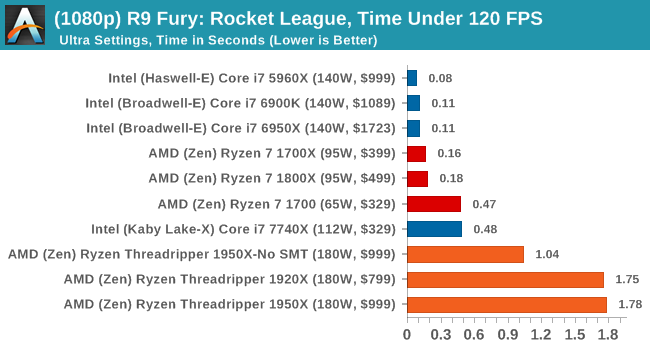
4K
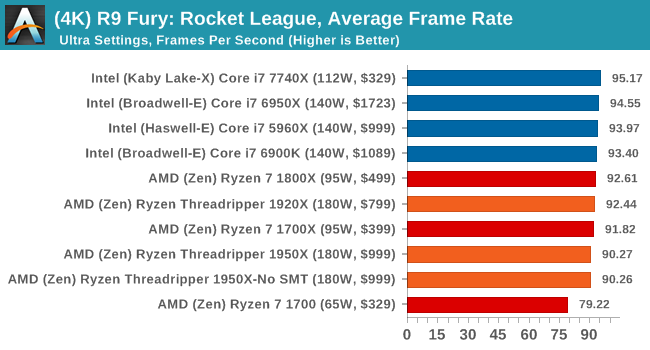
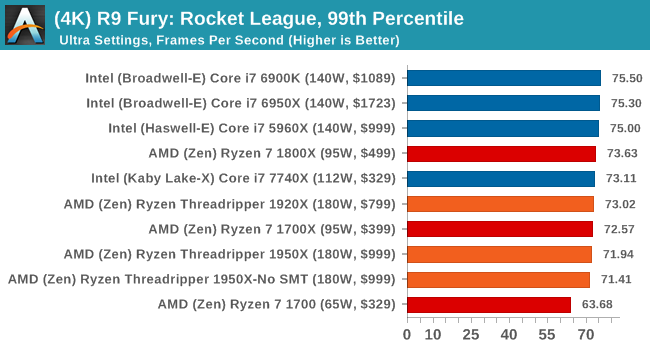

Sapphire Nitro RX 480 8G Performance
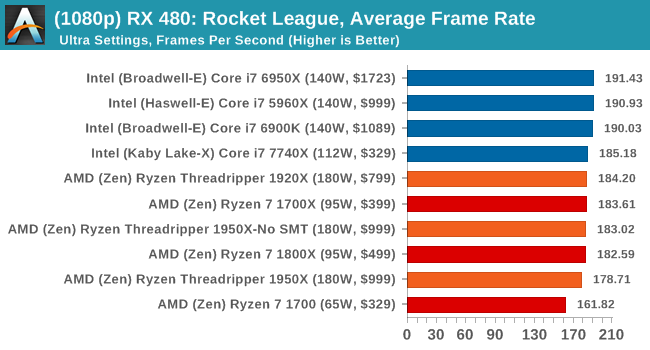
1080p

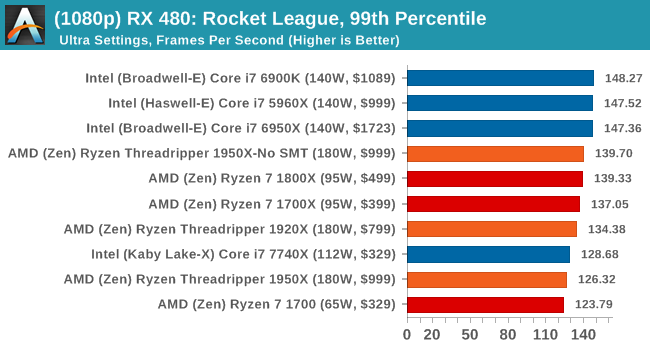
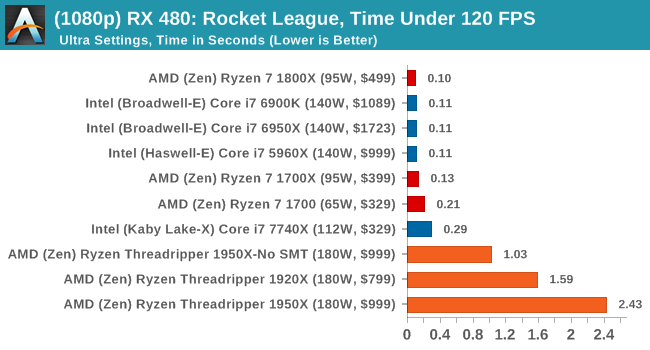
4K
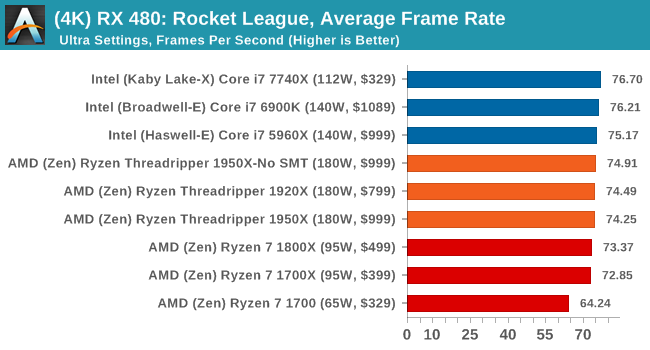
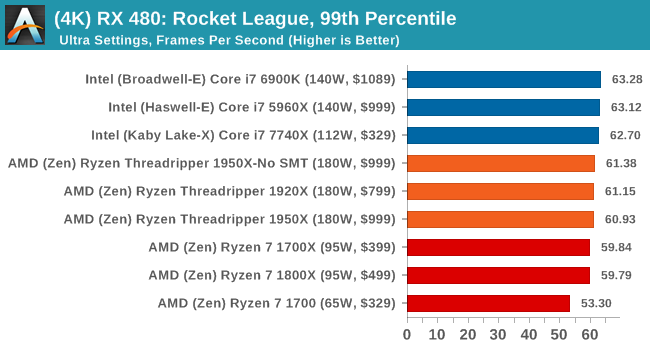
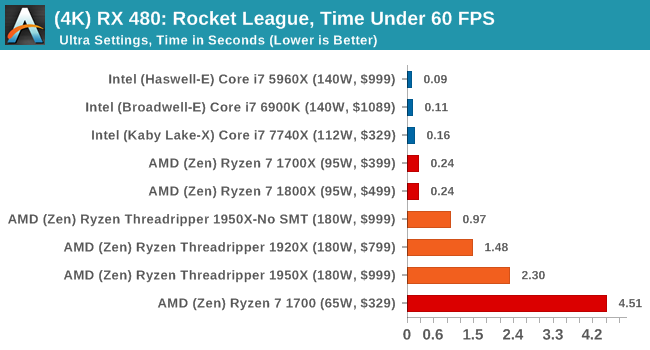
With Ryzen, we encounted some odd performance issues when using NVIDIA-based video cards that caused those cards to significantly underperform. However equally strangely, the issues we have with Ryzen on Rocket League with NVIDIA GPUs seem to almost vanish when using Threadripper. Again, still no easy wins here as Intel seems to take Rocket League in its stride, but SMT-off mode still helps the 1950X. The Time Under graphs give some cause for concern, with the 1950X consistently being at the bottom of that graph.



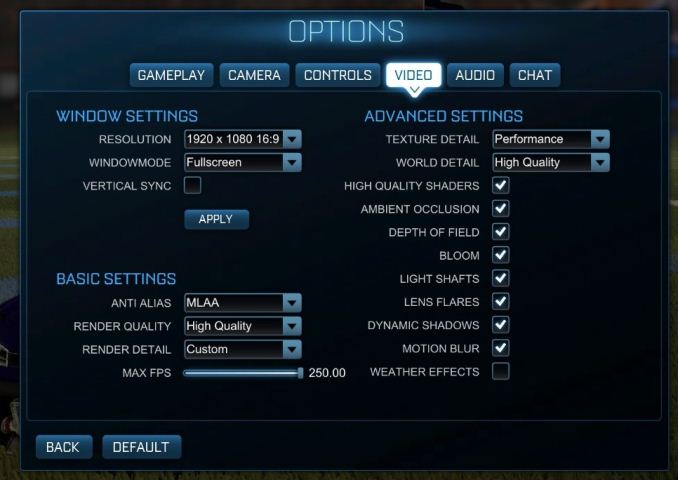








347 Comments
View All Comments
Vorl - Thursday, August 10, 2017 - link
the answer to both of you is that "this is a High end PC processor, not a workstation CPU, and not a server CPU. That was clearly covered at the start of the article.If you want raw number crunching info, there will be other sites that are going to have those reviews, and really, maybe anandtech will review it in that light since it really is such a powerful CPU in another review for server stuff.
Also, there is a LOT of value in having a standardized set of tests. Even if a few tests here and there are no longer valuable like PDF opening, the same tests being used across the board are important for BENCH. you can't compare products if you aren't using the same tools.
Unfortunately AMD is ahead of the curve currently with massive SMP being given to normal consumers now at a reasonable price. It will take a little time for dev's to catch up and really make use of this amazing CPU.
With the processing power in a CPU like this imagine the game mechanics that can be created and used, For those of us that are more interested in making this a reasonably priced workstation/server build for VMs etc, cool for us, but that isn't where this is being marketed, and it's not really fair to jump all over the reviewer for it.
Zstream - Thursday, August 10, 2017 - link
Utter rubbish. This CPU is designed for a workstation build. Some a product labeled Xeon is a workstation CPU, but this isn't?mapesdhs - Friday, August 11, 2017 - link
Yeah, TR doesn't really look like something that's massively aimed at gamers, it has too many capabilities and features which gamers wouldn't be interested in.pm9819 - Friday, August 18, 2017 - link
AMD themselves call it a consumer cpu. Is Intel paying them as wellLolimaster - Friday, August 11, 2017 - link
It's a HEDT/workstation, a year ago people called Workstation a dual Xeon 8 cores, which a sole 1950X replicates.Intel draws a line not supporting ECC, AMD supports ECC in all their main cpu's server or not all the way back to Athlon 64.
16cores/32threads, ECC, 64 pci-e lanes, upgrade path to 32cores/64threads with zen3. Smells Workstation to me.
Another thing is server cpu's which EPYC is, with features tailored to it, like a massive core count with low clock speeds to maximize efficiency and damn expensive mobos without any gamerish gizmo, just think to put on building without looking at net. TR can do a bit of that too, but optimized to an all around performance and budget friendly.
Ian Cutress - Thursday, August 10, 2017 - link
Dan sums it up. Some of these tests are simply check boxes - is it adequate enough.Some people do say that an automated suite isn't the way to do things: unfortunately without spending over two months designing this script I wouldn't have time for nearly as much data or to test nearly as many CPUs. Automation is a key aspect to testing, and I've spent a good while making sure tests like our Chromium Compile can be process consistent across systems.
There's always scope to add more tests (my scripts are modular now), if they can be repeatable and deterministic, but also easy to understand in how they are set up. Feel free to reach out via email if you have suggestions.
Johan Steyn - Thursday, August 10, 2017 - link
Ian, I understand that you see them as checkboxes, but this is not a normal CPU John doe is going to buy. It has a very specific audience and I feel you are missing that audience badly. I guy that buys this to use for rendering or 3Dstudio Max, is not going to worry about games. Yes, it would be a great bonus to also be OK at it. Other sittes even did tests of running rendering as well as play games at the same time. TR shined like a star against Intel. This is actually something that might happen in real life. A guy could begin a render and then while waiting, decide to play a game.I would not buy TR to open pdf's, would I?
Ian Cutress - Thursday, August 10, 2017 - link
No, but you open things like IDEs and Premiere. A PDF test is a gateway test in that regard with an abnormally large input. When a workstation is not crunching hard, it's being used to navigate through programs with perhaps the web and documents in tow where the UX is going to be indicative of something like PDF opening.Lolimaster - Friday, August 11, 2017 - link
Including useless benchs not only you waste target audience time, you too having to write and upload images from that useless benchs instead of making the article more interesting.How about a "the destroyer for HEDT/Workstion", a typical productivy load + some gaming, out of a sudden people will get TWICE the cpu resources, they can do things they couldn't before on the same machine.
They could get a dual socket mobo with 2x10c Xeons paying the hefty premium with pathetic clock speeds if they wante to game a bit while doing work, TR fixed that, with mass consumer type of gaming performance while reducing the multicore costs by more than half (cores counts + ECC support without paying intel tax).
Lolimaster - Friday, August 11, 2017 - link
And that audience few months ago was limited to do their productivity thing with 6-8 cores or 10 paying the huge intel tax, probably they couldn't game without hurting other things and had a 2 secondary PC for killing time.With TR and the massive 16 core count they can finally do all of that off a single PC or focus the entire powerhorse when they need (leaving things do work during their sleep).